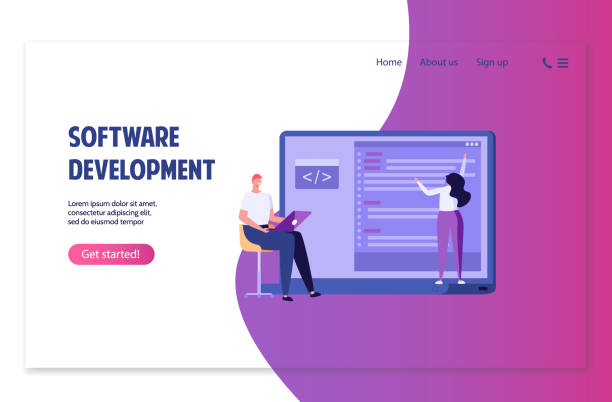Understanding Responsive Website Design and its Importance in Today’s World
![]()
In today’s digital world, where users connect to the internet with a variety of devices, from smartphones and tablets to laptops and smart TVs, the importance of #Responsive_Design is more evident than ever.
Responsive website design refers to a web development approach that enables websites to automatically adjust their layout and content to the size of the user’s device screen.
This adaptability provides a seamless and optimized user experience for every visitor, regardless of the type of device they are using.
The main goal of responsive design is to eliminate the need to develop separate versions of a website for each platform, saving both time and cost.
In the past, many websites were only optimized for desktop displays and offered an unpleasant user experience when viewed on mobile devices; including the need for constant zooming in and out or horizontal scrolling.
However, with the advent of new technologies and increased use of portable devices, responsive website design has become an industry standard.
This approach ensures that your website not only looks good but is also fully functional and accessible on any screen size, thereby significantly improving #User_Experience and #Accessibility.
This is a fundamental and essential topic for anyone who wants to have a successful presence in the web world.
Are you worried about losing customers because you don’t have a professional e-commerce website?
With e-commerce website design by Rasawweb, forget these worries!
✅ Significant increase in sales and visitor-to-customer conversion rate
✅ Professional and user-friendly design that builds customer trust
⚡ Get free consultation from Rasawweb
Why Responsive Website Design is No Longer an Option, but a Necessity?

In the past, responsive website design might have been considered a competitive advantage, but today this approach has become an absolute necessity.
One of the main reasons for this transformation is the changing pattern of user consumption; a significant portion of internet traffic occurs via mobile devices.
Therefore, if your website is not optimized for mobile, you will lose a large segment of your audience.
From an #SEO perspective, Google has explicitly stated that it ranks mobile-friendly websites higher in its search results.
With the Mobile-First Indexing algorithm, the mobile version of your site is the main criterion Google uses for ranking, not the desktop version.
This means that if you do not have responsive website design, you will likely lose your rank in search engines and be less visible.
Furthermore, the conversion rate is also heavily influenced by this issue.
A website that does not display correctly on different devices tires users and quickly forces them to leave the page (increasing the bounce rate).
In contrast, a responsive website provides a positive user experience that leads to an increase in user retention time on the site and, ultimately, an improvement in the #Conversion_Rate, whether your goal is to sell products, generate leads, or provide information.
Finally, the issue of #Accessibility arises.
Responsive design makes your website more accessible to a wide range of users, including people with disabilities who use assistive technologies.
Ignoring this necessity not only harms your business but also deviates from the ethics and standards of the modern web.
Are you willing to risk losing a large market share and falling behind competitors? The answer is clear: No.
Key Principles and Implementation Techniques of Responsive Design

Successful implementation of responsive website design is based on three fundamental principles: Fluid Grids, Flexible Images, and Media Queries.
Fluid Grids: This principle refers to the use of relative units (such as percentages) instead of fixed units (such as pixels) to define column widths, margins, and spacing in a website’s layout.
With this approach, the website’s layout, instead of being locked into a fixed size, automatically adjusts to the user’s screen dimensions and optimizes the available space.
This concept forms the core of responsive layouts.
Flexible Images: Images and other media elements must also be responsive.
This means their size should change proportionally with the available screen space to prevent content overflow or the loading of excessively large images on small devices.
Techniques such as using the max-width: 100% property in CSS, or using the srcset attribute and the <picture> element in HTML, help optimize images for various devices.
Media Queries: These are the backbone of responsive website design.
Media queries allow you to apply different CSS styles based on device characteristics such as screen width, height, orientation (horizontal or vertical), and resolution.
For example, you can define that if the screen width is less than 768 pixels, the navigation menu turns into a hamburger icon or fonts become smaller.
This capability provides precise control over the website’s appearance at various Breakpoints.
Below is a table of common breakpoints in responsive design:
| Device Type | Breakpoints (pixels) | Usage Example |
|---|---|---|
| Smartphones (Small) | 320px – 480px | Single column, larger fonts, collapsible navigation menu |
| Smartphones (Large) and Tablets (Portrait) | 481px – 768px | Two columns, medium sizes for images |
| Tablets (Landscape) and Small Laptops | 769px – 1024px | Three columns, full navigation |
| Desktops and Large Monitors | Above 1025px | Four columns or more, more complex layouts |
Popular Tools and Frameworks in Responsive Website Design

To facilitate the complex process of responsive website design, developers leverage numerous tools and frameworks that can significantly speed up development and reduce confusion.
Among the most popular of these frameworks are #Bootstrap and #Foundation.
These frameworks provide a set of predefined HTML, CSS, and JavaScript components that are designed from the ground up for responsiveness and adaptability.
For example, Bootstrap, with its 12-column grid system, allows for the creation of complex and responsive layouts with minimal coding, and also includes UI components like forms, buttons, and navigations that automatically adjust to screen size.
In addition to comprehensive frameworks, new CSS techniques like #CSS_Flexbox and CSS Grid are also powerful tools for responsive layouts.
Flexbox is a one-dimensional layout module very useful for distributing space and aligning items in a row or column, while CSS Grid is a two-dimensional layout system that allows you to define complex, grid-based layouts with rows and columns.
These features provide incredible flexibility in controlling website layout across different screen sizes and allow designers to build fully responsive websites without needing heavy frameworks.
Using web development frameworks or advanced CSS techniques makes optimizing and maintaining a website over time much easier, as many of the complexities related to screen size adaptability are already handled by these tools.
These tools not only simplify the process of building responsive website design but also contribute to the site’s stability and better long-term performance.
Don’t have a corporate website yet and missing out on online opportunities? With professional corporate website design by Rasawweb,
✅ Double your business’s credibility
✅ Attract new customers
⚡ Free consultation for your corporate website!
The Impact of Responsive Design on SEO and Your Website’s Visibility

As previously mentioned, there is a close relationship between responsive website design and search engine optimization (SEO), and ignoring it can come at the cost of your website’s visibility.
Google, the world’s leading search engine, has long considered “mobile-friendliness” a crucial ranking factor.
Since 2018, Google has adopted the “Mobile-First Indexing” approach; meaning that for ranking and indexing websites, it considers the mobile version of your site as the primary and reference version.
If your website lacks responsive design and does not provide a suitable user experience on mobile, your ranking in search results will significantly decrease.
A responsive website also helps improve other important #SEO factors.
For instance, responsive website design typically leads to faster #Page_Load_Speed on mobile devices, which is itself a critical ranking factor.
Users expect websites to load within a few seconds, and if your site is slow, they will quickly leave it, which leads to an increased bounce rate and, consequently, negative signals to search engines.
Furthermore, having only one URL for all devices (unlike having separate m.site.com versions) simplifies SEO management.
This prevents issues like duplicate content and concentrates link power on a single URL.
A website that is well-optimized for mobile and has strong SEO will, by improving its #Google_Ranking, not only be more visible but also attract more users, ultimately ensuring your online traffic and success.
Enhancing User Experience with a Responsive Web Design Approach

One of the most important advantages of responsive website design is its direct and positive impact on #User_Experience (UX).
In fact, the main goal of responsive design is to provide an unparalleled and consistent user experience, regardless of the device the user is using.
When your website is displayed correctly on any screen size, users do not need to zoom, horizontal scroll, or struggle to find information.
This simplicity and fluidity of use significantly increases #User_Satisfaction.
With responsive website design, users can easily navigate the site, fill out forms, read content, and interact with the site’s interactive elements, without encountering display or performance issues.
This is especially critical for e-commerce; if the mobile shopping process is complicated and unpleasant, customers quickly abandon their purchase.
A responsive website reduces cart abandonment rates and increases purchase completion rates.
Furthermore, consistent appearance and functionality across different devices foster a sense of trust and professionalism.
Users trust websites that are usable in all conditions more, and their likelihood of returning is higher.
Increased #Usability and #Better_Interaction with the website not only help increase user retention time on the site but also encourage them to share your content more and become loyal customers.
Ultimately, responsive website design is not just a technical trend but a strategic investment in improving communication with the audience and ensuring their satisfaction.
Challenges and Common Mistakes in Implementing Responsive Website Design

Despite numerous advantages, implementing responsive website design can also come with challenges and mistakes that can reduce its effectiveness.
One of the most common issues is #Disordered_or_Disorganized_Content.
In an effort to adapt content to smaller screens, website elements sometimes get arranged in a disorderly or illogical manner, disrupting readability and user experience.
Design should be considered “Mobile-First” from the outset to prevent such problems.
Another mistake is the lack of optimization for #Unoptimized_Images.
Loading high-resolution images on mobile devices can lead to very slow loading speeds, which both degrades the user experience and harms the site’s SEO.
Using techniques such as lazy loading, next-generation image formats (like WebP), and proper image compression is essential.
Also, #Lack_of_Testing is a fatal mistake.
Many developers test their website only on a few popular devices or in browser simulators.
However, there are many differences in how a website displays and performs on various devices and browsers (cross-browser).
Comprehensive and thorough testing on real devices and diverse browsers is crucial to ensure the correct functioning of responsive website design.
Some other challenges include the complexity of managing CSS and JavaScript for multiple breakpoints, as well as issues with website navigation that may not work well on different screen sizes.
For success in web responsiveness, special attention must be paid to all these details, and appropriate testing tools and processes must be used to ensure an optimized website is delivered across all platforms.
Below is a table of common problems in responsive design and their solutions:
| Common Problem | Description | Proposed Solution |
|---|---|---|
| Heavy Images | Loading high-volume images that reduce site speed. | Compression, use of WebP format, Lazy Loading, srcset attribute. |
| Small or Large Texts | Inappropriate font size that makes readability difficult. | Use of relative units (rem, em, vw) and media queries for fonts. |
| Unclickable Elements | Buttons and links too small for finger touch. | Ensuring a minimum size of 48px by 48px for touch targets. |
| Complex Mobile Navigation | Cluttered or difficult menus on small devices. | Use of a hamburger menu, dropdown menus, or simpler navigation. |
A Look into the Future of Responsive Web Design and Upcoming Innovations

Responsive website design, while a relatively new concept itself, is constantly evolving and progressing.
The future of this field is moving towards smarter and more complex approaches that consider not only screen dimensions but also other factors such as input type (touch, mouse, voice), network speed, and even user preferences.
One important trend is #Content-Driven_Design.
This approach emphasizes the idea that content should be at the heart of the design process, and layouts should adapt based on the importance and structure of the content, not merely screen size.
This means providing a more meaningful and content-centric user experience on any device.
Speed and performance will also remain a key focus.
With the emergence of technologies like Accelerated Mobile Pages (AMP) and Progressive Web Apps (PWAs), responsive design is expected to integrate more with #High_Speed and offline capabilities.
PWAs offer users an app-like experience in the browser, while AMP significantly increases page loading speed on mobile.
These technologies help responsive websites compete functionally with native applications.
Furthermore, with the proliferation of Wearables and the Internet of Things (IoT), the concept of responsive website design will extend beyond traditional displays.
Designers must consider delivering content and user experience on very small screens, voice user interfaces, and even Augmented Reality (AR) and Virtual Reality (VR).
These #New_Interactions will require a completely different way of thinking about website responsiveness and adaptability.
In summary, the future of responsive web design appears more dynamic and exciting than ever, promising completely personalized and immersive experiences.
Did you know that customers’ first impression of your company is your website? With a powerful corporate site from Rasawweb, multiply your business’s credibility!
✅ Exclusive and eye-catching design tailored to your brand
✅ Improved user experience and increased customer acquisition
⚡ Get a free consultation!
Testing and Optimizing Responsive Websites for Maximum Performance

After implementing responsive website design, the testing and optimization phase is of utmost importance to ensure that the website functions correctly across all devices and browsers and delivers flawless performance.
#Cross-Browser_Testing is vital; this process involves checking the website on various browsers (such as Chrome, Firefox, Safari, Edge) and different operating systems (Windows, Mac, Android, iOS).
Also, the website’s performance must be evaluated on real devices with diverse screen sizes, from the smallest smartphone to the largest desktop monitor.
Simulators and emulators can be useful, but the best way to ensure a real user experience is to test on actual hardware.
Browser #Developer_Tools such as Chrome DevTools, Firefox Developer Tools, and Safari Web Inspector are powerful tools for simulating various devices, inspecting media queries, and debugging CSS and JavaScript issues across different screen sizes.
These tools allow you to easily change layouts and observe their effects live.
For #Performance_Optimization, tools like Google PageSpeed Insights and Lighthouse can help identify bottlenecks and provide suggestions for improving loading speed and overall website performance.
Image optimization (compression and use of responsive images), reducing HTTP requests, minifying CSS and JavaScript, and utilizing caching are among the key techniques to improve the performance of a responsive website.
The correct implementation of responsive website design would be incomplete without a thorough and continuous testing and optimization process.
Conclusion: Responsive Website Design, a Platform for Sustainable Success

In summary, responsive website design is no longer a luxury feature or an option, but an essential cornerstone of any successful online presence in today’s world.
Given the increasing trend of using mobile devices to access the internet, a well-responsive website is the only way to ensure a flawless user experience for all visitors.
This approach not only improves #User_Experience and increases #User_Satisfaction but also directly impacts your website’s #SEO, helping you achieve higher rankings in search results and attract more traffic.
Responsive website design allows you to serve a wide range of devices and screen sizes with just one version of your website, which not only simplifies site management and maintenance but also reduces development costs in the long run.
This is a #Smart_Investment in the future of your online business, leading to sustainability and growth.
Given the continuous evolution of web technologies and the emergence of new devices, a responsive website creates a sustainable competitive advantage.
This concept is, in fact, the foundation of the #Future_of_Web, and any business or individual seeking an effective and growing presence in the digital space should prioritize it.
By embracing the principles of responsive website design, you not only build a website that performs excellently today but also prepare it for the challenges and opportunities of tomorrow.
This approach paves the way for sustainable success and effective communication with your audience anytime, anywhere.
Frequently Asked Questions
| Question | Answer |
|---|---|
| What is Responsive Web Design? | It is a website design method that optimizes the appearance and functionality of a website according to the screen size of the user’s device (mobile, tablet, laptop, etc.). |
| Why is responsive design important? | Due to the increased use of various devices for internet access, responsive design provides a better user experience, improves website SEO, and reduces maintenance costs. |
| What are the most important tools for responsive design? | CSS Media Queries, use of relative units (such as percentage, em, rem, vw, vh), Flexible Images, and Grid Systems. |
| What role do Media Queries play in responsive design? | Media Queries allow the application of different CSS styles based on device characteristics (such as screen width, height, orientation, and screen type). |
| What is the Mobile First concept in responsive design? | It is an approach where design and development begin first for the smallest screen (mobile) and then gradually expand to larger screens (tablet, desktop). |
| Does responsive design affect website SEO? | Yes, Google prefers responsive websites because they provide a better user experience and eliminate the need for separate mobile and desktop versions, which helps improve SEO ranking. |
| What does Fluid Layout mean? | It means that the width of page elements is defined using relative units (such as percentages) instead of fixed pixel values, so they automatically adjust with changes in screen size. |
| How are Flexible Images used in responsive design? | By setting the `max-width: 100%;` property for images in CSS, it is ensured that the image never exceeds its container and its scale is maintained as the screen size changes. |
| What are the differences between responsive design and adaptive design? | Responsive design uses a single layout that fluidly adapts to any screen size, while adaptive design uses several fixed, predefined layouts for specific screen sizes. |
| Are CSS frameworks like Bootstrap useful in responsive design? | Yes, frameworks like Bootstrap have a responsive Grid System and pre-designed components that make the process of building responsive websites much simpler and faster. |
And other services of Rasa Web Advertising Agency in the field of advertising
Smart Data Analysis: A fast and efficient solution to increase click-through rates with a focus on marketing automation.
Smart UI/UX: A professional solution to improve SEO ranking with a focus on SEO-driven content strategy.
Smart Customer Journey Map: Designed for businesses looking to increase click-through rates through Google Ads management.
Smart Customer Journey Map: A combination of creativity and technology for digital branding through key page optimization.
Smart Direct Marketing: A professional solution to improve SEO ranking with a focus on attractive user interface design.
And over hundreds of other services in the field of internet advertising, advertising consulting, and organizational solutions
Internet Advertising | Advertising Strategy | Advertorials
Sources
The Future of Responsive Design on Digiato
Responsive Design Trends on Zoomit
The Role of Responsive Design in the Modern Web
The Evolution of Responsive Design on Webramz
? Are you looking to elevate your business in the digital world? Rasaweb Afarin Digital Marketing Agency offers comprehensive SEO-optimized website design services to help you shine online and achieve your goals. Experience a powerful and memorable presence with us.
📍 Tehran, Mirdamad Street, next to Bank Markazi, Kazeroon Janubi Alley, Ramin Alley, No. 6




